A deep-dive abstract into the open-plan office layout by Jungsoo Kim*, Richard de Dear
Faculty of Architecture, Design and Planning, Wilkinson Building G04, The University of Sydney, NSW 2006, Australia
1.Introduction
There exists a large body of literature looking at how physical environment influence occupants’ perception and behaviour in office buildings. As office layout has transitioned in recent decades from conventional private (or cellular) spatial configuration to modern open-plan, the impacts on occupants and organisations have been extensively studied from a variety of perspectives in disciplines as diverse as architecture, engineering, health and psychology.
In addition to tangible economic benefits of open-plan offices such as increased net usable area, higher occupant density and ease of reconfiguration (Duffy, 1992; Hedge, 1982), the open-plan office layout is believed by many to facilitate communication and interaction between co-workers by removing internal walls, which should improve individual work performance and organisational productivity (Brand & Smith, 2005; Kupritz, 2003). However there is not much empirical evidence to support these widespread beliefs (Kaarlela-Tuomaala, Helenius, Keskinen, & Hongisto, 2009; Smith-Jackson & Klein, 2009). On the contrary, a plethora of research papers identify negative impacts of open-plan office layout on occupants’ perception of their office environment. For example, some longitudinal survey results have demonstrated a significant decline in workspace satisfaction (Sundstrom, Herbert, & Brown, 1982), increased distraction and loss of privacy (Kaarlela-Tuomaala et al., 2009), and perceived performance decrement (Brennan, Chugh, & Kline, 2002) after relocation of employees from enclosed workplace to open-plan or less-enclosed workplace. Moreover, the occupants in these studies didn’t adapt or habituate to the change in spatial layout (Brand & Smith, 2005; Brennan et al., 2002; Virjonen, Keränen, Helenius, Hakala, & Hongisto, 2007), and many researcher draw the causal link between declining environmental satisfaction and deteriorating job satisfaction and productivity (Sundstrom, Town, Rice, Osborn, & Brill, 1994; Veitch, Charles, Farley, & Newsham, 2007; Wineman, 1982). Still other research studies attribute escalating Sick Building Syndrome (SBS) symptoms such as distress, irritation, fatigue, headache and concentration difficulties (Klitzman & Stellman, 1989; Pejtersen, Allermann, Kristensen, & Poulsen, 2006; Witterseh, Wyon, & Clausen, 2004) to open-plan office layout.
An extensive research literature consistently identifies noise and lack of privacy as the key sources of dissatisfaction in open-plan office layouts (Danielsson & Bodin, 2009; de Croon, Sluiter, Kuijer, & Frings-Dresen, 2005; Hedge, 1982). Firstly, studies based on either occupant surveys and laboratory experiment report that noise, in particular irrelevant but audible and intelligible speech from co-workers, disturbs and negatively affects individual performance on tasks requiring cognitive processing (Banbury & Berry, 2005; Haka et al., 2009; Smith-Jackson & Klein, 2009; Virjonen et al., 2007). The loss of productivity due to noise distraction estimated by self-rated waste of working time was doubled in open-plan offices compared to private offices, and the tasks requiring complex verbal process were more likely to be disturbed than relatively simple or routine tasks (Haapakangas, Helenius, Keekinen, & Hongisto, 2008). Also, Evans and Johnson (2000) argue that exposure to uncontrollable noise can be associated with fall in task motivation. Secondly, with a reduced degree of personal enclosure, open-plan layout often fails to isolate the occupants from unwanted sound (i.e., sound privacy) and unwanted observation (i.e., visual privacy), resulting in the overall feeling of loss of privacy and personal control over their workspace (Brand & Smith, 2005; Brill, Margulis, Konar, & BOSTI, 1985; Danielsson & Bodin, 2009; O’Neill & Carayon, 1993). Consequently, occupants experience excessive uncontrolled social contact and interruptions due to close proximity to others and perceived loss of privacy, known as overstimulation, which leads to occupants’ overall negative reactions toward their office environment (Maher & von Hippel, 2005; Oldham, 1988).
Although that the absence of interior walls in open-plan office layout purportedly improves communication within teams and, in turn, enhances employee satisfaction, the presumption of improved workplace satisfaction is yet to be verified. Indeed, the disadvantages of open-plan offices dominate previous research outcomes. To date there has been no attempt at quantifying pros and cons of the open-plan office layout. Hedge (1982) opined that the improved social climate within open-planed offices was insufficient to offset the occupants’ negative reactions to this spatial workplace configuration, but attached no empirical evidence to support this argument. Thus the primary objective of this paper is to weigh up the positive impact of the purported advantages of open-plan office (i.e., interaction between colleagues) against the negative impact of the disadvantages (i.e., noise and privacy) in relation to occupants’ overall satisfaction with their workspace. This study also explores how occupants’ attitude toward indoor environment changes between different office layouts categorized depending on the degree of personal enclosure. For example, an occupant located in a spacious private office would have different expectations or priority for Indoor Environmental Quality (IEQ) compared to an occupant located in a dense, open-plan office. To summarise, the research questions addressed in this paper are:
- Does occupant satisfaction with various IEQ factors change depending on different office layouts?
- Does the priority of various IEQ factors (i.e. relative importance for shaping occupants’ overall workspace satisfaction) differ between occupant groups in different office layouts?
- Do the benefits such as easiness of interaction between co-workers offset the disadvantages such as distraction by noise and loss of privacy in the open-plan office layout?
2. Methods
2.1. Occupant survey database
Although the influence of the office environment on occupants has attracted interdisciplinary research attention over recent decades, the literature remains incoherent and ambiguous. This is possibly the result of a failure on the part of researchers to agree on common or standardised instruments to measure occupant ratings of their work environment (Veitch et al., 2007). Therefore the empirical analysis in the present paper is based on an “industry standard” Post-Occupancy Evaluation (POE) database from CBE (Center for the Built Environment) at the University of California, Berkeley. CBE’s occupant survey questionnaire is one of the most widely used POE tool at present and is also prescribed within the IEQ section of building rating systems such as LEED (USGBC, 2009) and in Australia, NABERS (2009).
CBE has conducted the occupant survey since 2000 and accumulated data from buildings with various occupancy types. It was developed as a web-based survey tool assessing the building occupants’ satisfaction ratings for various IEQ aspects including thermal comfort, air quality, lighting, acoustics, office layout, office furnishings, cleanliness & maintenance, and overall workspace satisfaction (Brager & Baker, 2009; Zagreus, Huizenga, Arens, & Lehrer, 2004). The survey respondents express their satisfaction level with each questionnaire item on the seven-point scale ranging from ‘very dissatisfied’(coded as 3) through ‘neutral’ (coded as 0) to ‘very satisfied’ (coded as +3). Table 1 summarises the questionnaire items used in the analysis for this study. The database also contains information about survey participants’ demographics and the building’s characteristics such as design features, service systems, materials and other technical aspects. CBE’s database contains POE responses from various types of buildings including offices, hospitals, schools, commercial, residential, industrial, etc.(Frontczak et al., 2012). Since this study focuses on the influence of different office layouts on occupant responses, our analysis is based on the office building subset (a total of 42,764 samples collected in 303 office buildings) of the entire CBE database. Survey respondents’ personal characteristics such as gender, age (30 or under, 31-50, and over 50), and type of work (administrative support, technical, professional, and managerial) are described in Table 2.
CBE’s questionnaire classifies the office layouts into five categories, depending on the level of personal enclosure: (1) Enclosed private office; (2) Enclosed shared office; (3) Cubicles with high partitions (about five or more feet high); (4) Cubicles with low partitions (lower than five feet high); and (5) Open office with no partitions or limited partitions. The number of survey samples within each office layout category is listed in Table 3. The CBE’s POE database does not contain a specific description of architectural or functional characteristics, nor the number of people sharing. Danielsson and Bodins’ (2008) definitions and descriptions of typical office layout have been superimposed on the CBE nomenclature and are included in Table 3. Two thirds of individual responses (66.9%) are from open-plan office layout (including cubicles with high partitions, cubicles with low partitions and open office with no partitions or limited partitions). Among the different configurations of open-plan offices, high-partitioned cubicle is the single most popular office configuration within the CBE database (37.7% of the total occupants). About a quarter of the survey respondents occupied private offices (26.6%) and a small fraction of the sample shared single-room offices with co-workers (6.4%).
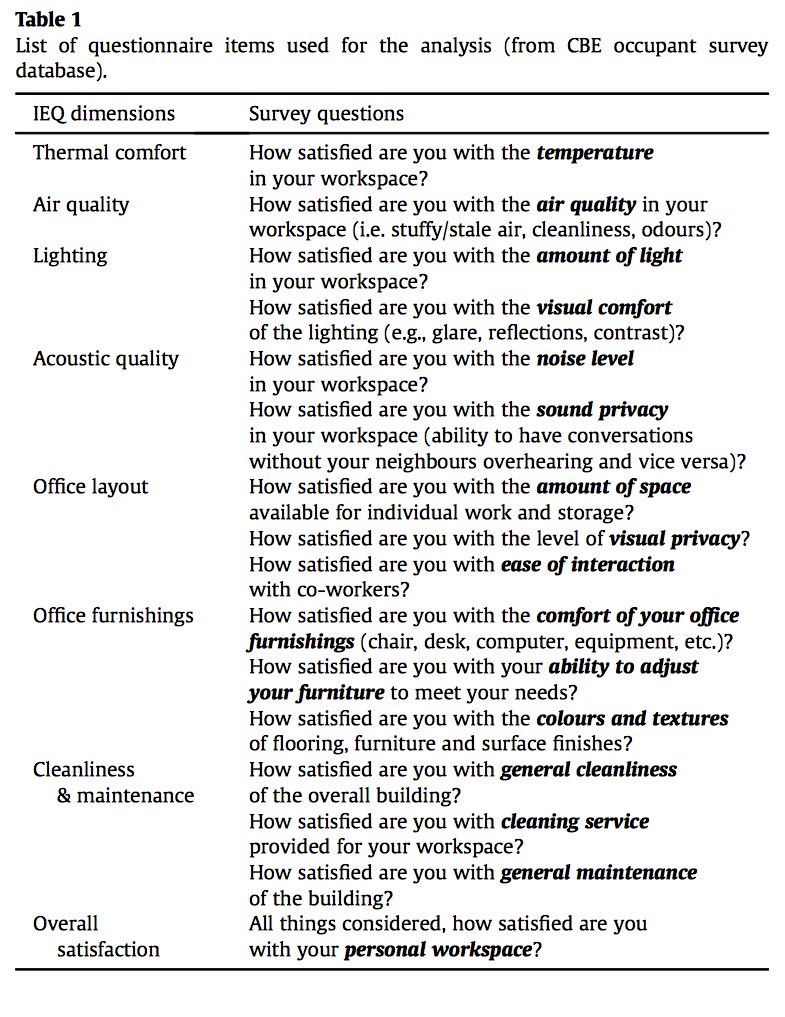
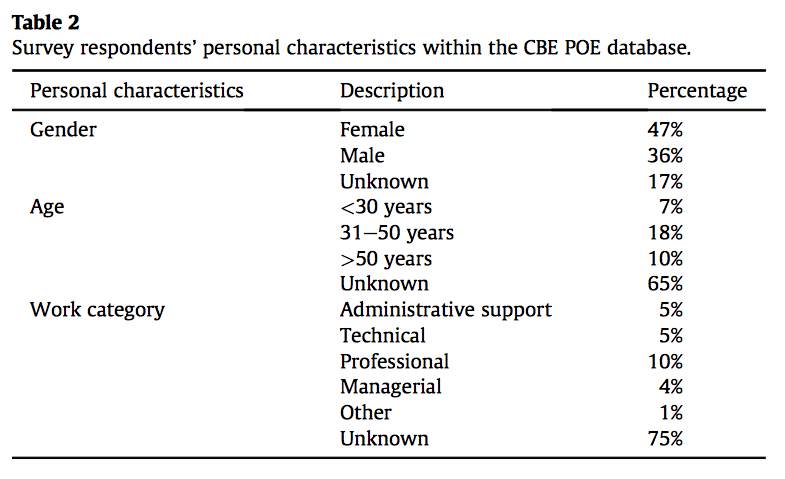
2.2. Data analysis
First, the survey respondents’ satisfaction level with each IEQ issue in Table 1 is examined. Also the percentage of highly dissatisfied occupants, i.e. those who voted on the bottom two ratings on the seven-point satisfaction scale, is computed. The percentage of dissatisfied is regarded as a meaningful and practical metric in thermal comfort studies because it can be readily interpreted as an expression of the number of potential complaints (Fanger, 1972). Thus together with mean satisfaction score, Actual Percentage of Dissatisfied (APD) can be used to quantitatively assess whether occupants in different office layouts respond differently to the various IEQ aspects addressed in CBE’s questionnaire.
Second, to explore the implicit importance of various IEQ dimensions in relation to the occupants’ overall assessment on their workspace, multiple regression analysis is conducted with overall workspace satisfaction as the dependent variable and the remaining 15 IEQ factors in Table 1 as the independent variables. Different IEQ factors can be prioritised based on their strength of the relationship estimated by regression coefficients – with overall workspace satisfaction. Therefore how relative importance of the 15 IEQ factors differ between occupants in different office layouts can be investigated.
Last, in order to estimate positive and negative impacts of individual IEQ factors on occupant overall satisfaction, multiple regression analysis is conducted after dividing the survey responses into three subgroups using dummy variables. Multiple regression with dummy variable is a widely adopted analytical method in marketing research to estimate the differential impact of attribute performance on overall satisfaction under two circumstances; when an attribute is perceived to be satisfactory, and when it isn’t (e.g. Anderson & Mittal, 2000; Busacca & Padula, 2005; Matzler, Bailom, Hinterhuber, Renzl, & Pichler, 2004; Matzler, Fuchs, & Schubert, 2004). In other words, a positive impact increasing overall satisfaction when an attribute is performing well and a negative impact decreasing overall satisfaction when the attribute is performing poor can be separately estimated by this approach. This analytical method was adopted in the context of indoor environment by Kim and de Dear (2012) to identify the asymmetric effect of various IEQ factors on occupant workspace satisfaction. In our analysis, POE samples are divided into three subgroups using dummy coding (coded 0 or 1); (1) those who are highly satisfied with the IEQ factor in question (occupants who rated their satisfaction at the top two levels, i.e. +3 and +2); (2) those who are highly dissatisfied with the IEQ factor (occupants who rated their satisfaction at the lowest two levels, i.e. -3 and -2); and (3) those who are indifferent to the IEQ factor (occupants who rated their satisfaction level in the middle of the scale, i.e. -1, 0, and +1). Then the multiple regression model enables the prediction of change in outcome (i.e. overall workspace satisfaction) due to a unit change in the predictor from the baseline category (i.e. from indifferent to either satisfied or dissatisfied). Thus the increase or decrease in overall satisfaction, depending on whether an occupant is satisfied or dissatisfied with a particular IEQ factor can be estimated. The multiple regression analysis produces two coefficients for each of the IEQ factors: b1 for the satisfied group to measure the positive impact on overall satisfaction (when an IEQ factor is perceived to be performing well), and b2 for the dissatisfied group to measure the negative impact on overall dissatisfaction (when the IEQ factor is perceived to be performing poor). The absolute value of the regression coefficients is interpreted as the strength of each IEQ factor’s impact on occupant overall satisfaction with workspace. In particular, a positive impact (b1) of ‘ease of interaction’ and a negative impact (b2) of ‘visual privacy’, ‘sound privacy’ and ‘noise level’ can therefore be compared, which is addressed in our third research question.

3. Results
3.1. Satisfaction with different aspects of IEQ
Fig. 1 depicts the mean satisfaction scores for the IEQ questionnaire items, rated on the seven-point scale within the bounds of “very dissatisfied (3)” to “very satisfied (+3)” by occupants in five 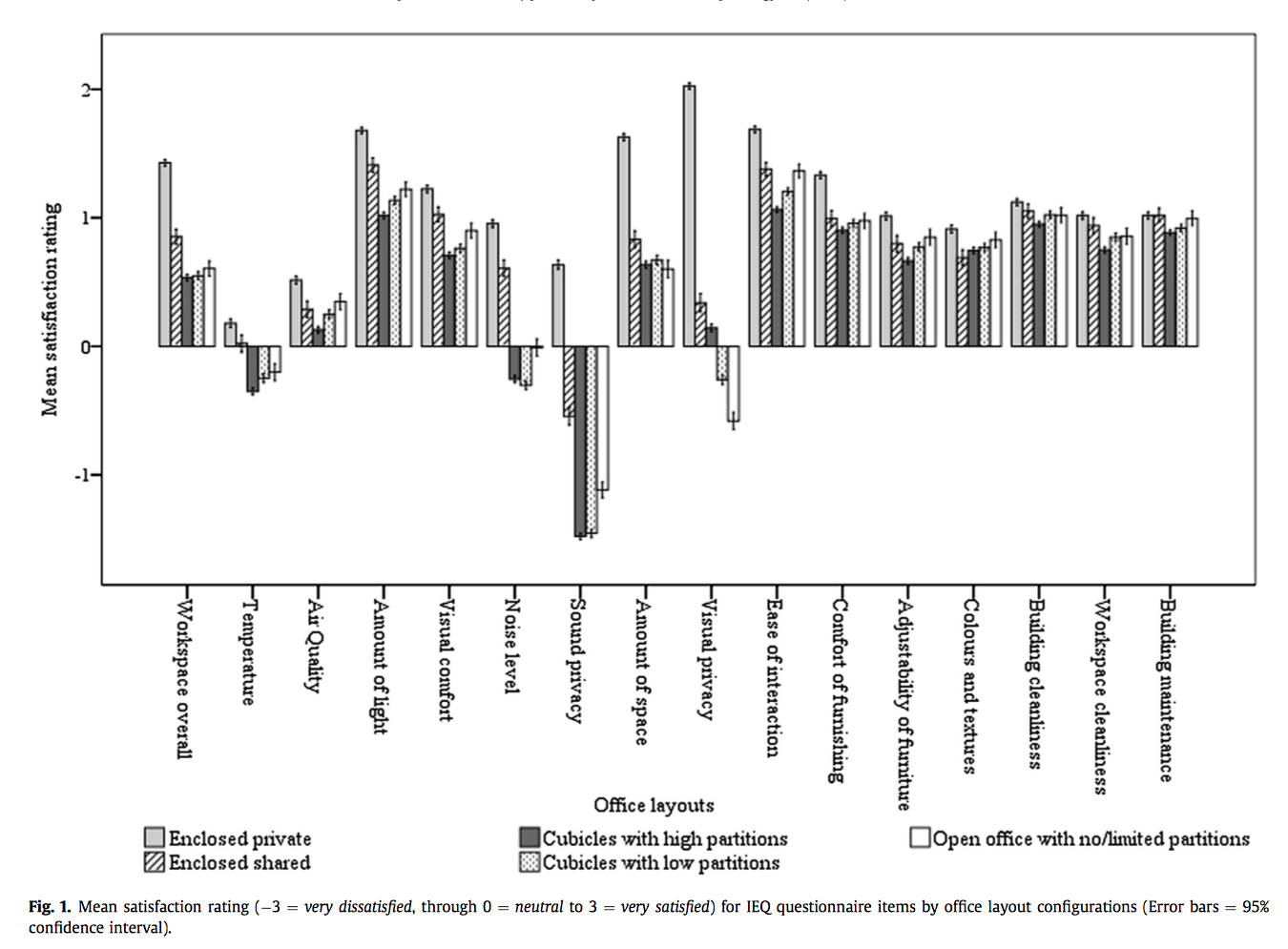 different office layouts. Enclosed private office registered the highest overall workspace satisfaction score, followed by enclosed shared office, then three configurations of open-plan offices (i.e. high partitioned, low partitioned and no/limited partitioned) with the similar average scores. Enclosed private office significantly outscored the other office layouts across most of the IEQ factors, and their occupants rated all aspects of IEQ positively. While some IEQ factors in private offices, such as ‘amount of light’ (+1.7), ‘amount of space’ (+1.6), ‘visual privacy’ (+2.0) and ‘ease of interaction’ (+1.7), achieved high satisfaction scores, ‘temperature’ (+0.2) and ‘air quality’ (+0.5) remained closed to neutral. The noticeable differences between enclosed offices and open-plan offices appeared on ‘visual privacy’, ‘amount of space’, ‘sound privacy’ and ‘noise level’. Open-plan offices scored considerably low in privacy, proxemics and noise distraction issues. Particularly ‘sound privacy’ received the most negative responses from occupants of shared room office (–0.5) and open-plan offices (high partitioned =1.5, low partitioned =1.5, and no/limited partitioned =1.1). Satisfaction with ‘visual privacy’ declined as the degree of enclosure decreased, but ‘sound privacy’ didn’t exhibit any correspondence with the degree of enclosure in office layout. Satisfaction with ‘ease of interaction’ was no higher in open-plan offices than in private office. Interestingly, among three open-plan configurations, occupants in no/limited partitioned office tend to be more satisfied with the most of IEQ factors except ‘visual privacy’, compared to those in cubicles. In general, cubicles with high partitions reported the lowest occupant satisfaction across 13 out of 15 of the IEQ factors. Across all five office layouts, occupants expressed slight satisfaction (+1) with cleanliness and maintenance issues, while thermal and air quality issues were more closed to neutral (0).
different office layouts. Enclosed private office registered the highest overall workspace satisfaction score, followed by enclosed shared office, then three configurations of open-plan offices (i.e. high partitioned, low partitioned and no/limited partitioned) with the similar average scores. Enclosed private office significantly outscored the other office layouts across most of the IEQ factors, and their occupants rated all aspects of IEQ positively. While some IEQ factors in private offices, such as ‘amount of light’ (+1.7), ‘amount of space’ (+1.6), ‘visual privacy’ (+2.0) and ‘ease of interaction’ (+1.7), achieved high satisfaction scores, ‘temperature’ (+0.2) and ‘air quality’ (+0.5) remained closed to neutral. The noticeable differences between enclosed offices and open-plan offices appeared on ‘visual privacy’, ‘amount of space’, ‘sound privacy’ and ‘noise level’. Open-plan offices scored considerably low in privacy, proxemics and noise distraction issues. Particularly ‘sound privacy’ received the most negative responses from occupants of shared room office (–0.5) and open-plan offices (high partitioned =1.5, low partitioned =1.5, and no/limited partitioned =1.1). Satisfaction with ‘visual privacy’ declined as the degree of enclosure decreased, but ‘sound privacy’ didn’t exhibit any correspondence with the degree of enclosure in office layout. Satisfaction with ‘ease of interaction’ was no higher in open-plan offices than in private office. Interestingly, among three open-plan configurations, occupants in no/limited partitioned office tend to be more satisfied with the most of IEQ factors except ‘visual privacy’, compared to those in cubicles. In general, cubicles with high partitions reported the lowest occupant satisfaction across 13 out of 15 of the IEQ factors. Across all five office layouts, occupants expressed slight satisfaction (+1) with cleanliness and maintenance issues, while thermal and air quality issues were more closed to neutral (0).
The Actual Percentage of Dissatisfied (APD) with each IEQ factor was illustrated in Fig. 2. As a conservative approach to separate those who are significantly dissatisfied, survey responses falling into the lowest two points on the seven-point satisfaction scale (i.e. very dissatisfied or dissatisfied) were counted towards APD. In general, open-plan layouts showed considerably higher dissatisfaction rates than enclosed office layouts. The highest levels of IEQ dissatisfaction were reported for ‘sound privacy’; more than half of the occupants in open-plan cubicles (59% for high partitioned cubicle and 58% for low partitioned cubicle) and just less than half (49%) in open-plan with no/limited partitions expressed dissatisfaction with the condition of sound privacy. ‘Temperature’, ‘noise level’ and ‘visual privacy’ were also identified as major sources of IEQ dissatisfaction going on the APD index. APD for occupants of enclosed private office fell well below 10% on most of the IEQ factors, but more than 20% of private office occupants expressed dissatisfaction with their thermal environmental conditions, implying thermal discomfort is a universal source of dissatisfaction across all five office layout configurations, regardless of privacy level. Also, relatively higher APD scores (18%) were reported on ‘sound privacy’ in private offices, but they performed significantly better on ‘visual privacy’ with APD dropping down to just 3%. According to Fig. 2, thermal environmental conditions, acoustic quality and privacy are the pervading IEQ problems in commercial buildings, scoring dissatisfaction rates in excess of 20%. In particular, 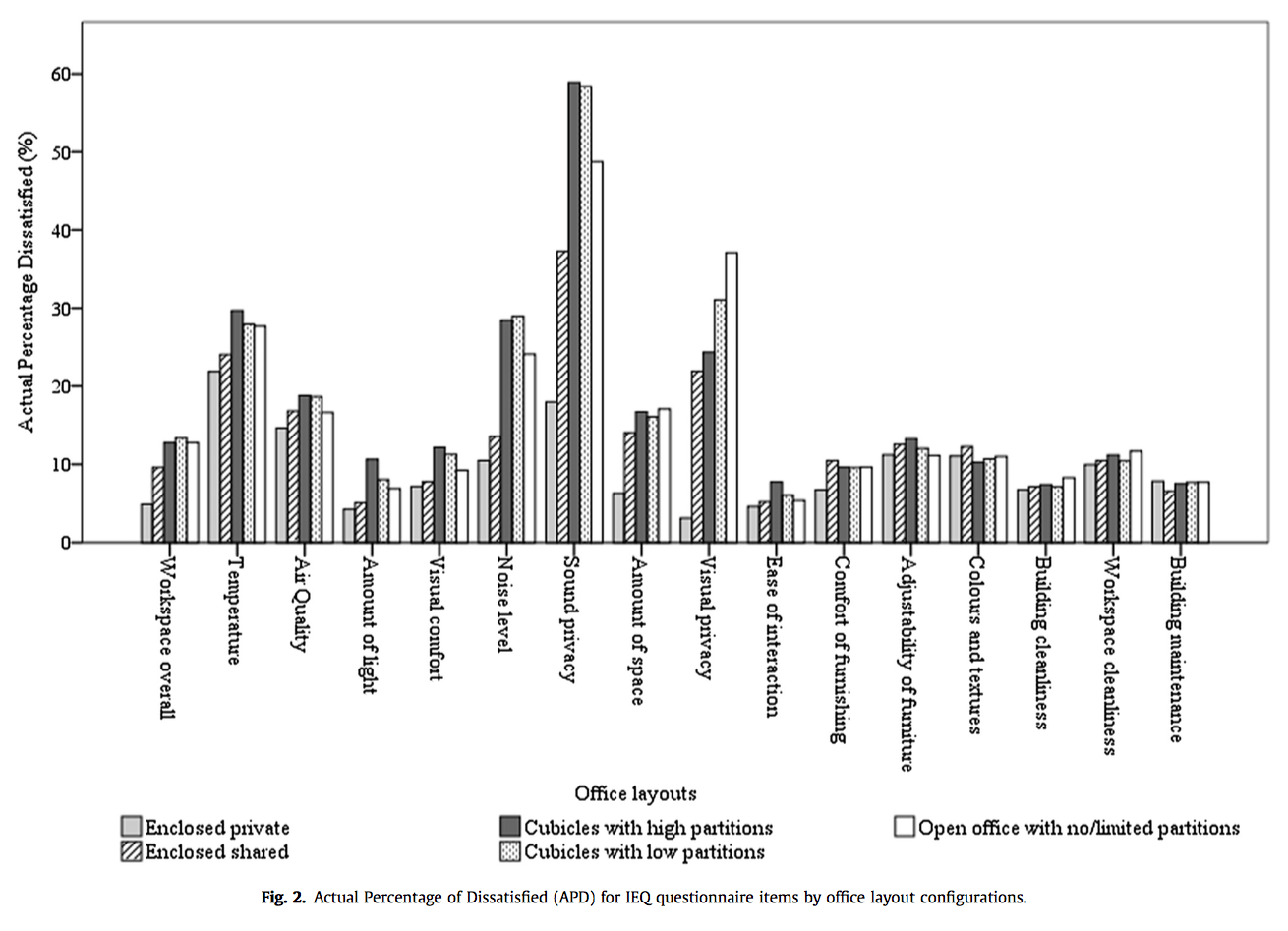 APD for ‘noise level’, ‘sound privacy’ and ‘visual privacy’ tended to increase considerably in open-plan layouts compared to private offices.
APD for ‘noise level’, ‘sound privacy’ and ‘visual privacy’ tended to increase considerably in open-plan layouts compared to private offices.
3.2. Implicit relative importance of different IEQ factors
To investigate whether the relative importance of different IEQ factors changes under the different spatial configurations, multiple regression analysis was conducted separately on survey responses from the five office layouts. The five survey subsamples with 15 IEQ items as the predictors all had high reliabilities (all Cronbach’s a = 0.89). Independence of predictors was confirmed by Variance Inflation Factor (1.3 < VIF < 3.4, while VIF = 5 is the threshold of multicollinearity). The five regression models explained between 63 and 65% of the variance in outcome variable (i.e. overall work-space satisfaction). Regression coefficients in this analysis represent the magnitude of individual IEQ factors’ influence on the occupants’ overall workspace satisfaction, and are presented in Table 4. For example, the IEQ factor showing the strongest relationship with occupants’ overall satisfaction was ‘amount of space’ (b = 0.21e 0.24) across all five office layouts. Cleanliness and maintenance issues had a much smaller influence on overall satisfaction (b = 0.03e0.07, or in some cases, insignificant).
Based on the regression coefficients in Table 4, a radar chart was created in Fig. 3 to visualise the different IEQ priorities of the five office layouts. Insignificant regression coefficients were excluded from the chart. Both similarities and differences between each occupant group can be noticed in Fig. 3. Regardless of office layout, the amount of space available for individual work and storage was identified as the most significant IEQ determinant of occupant workspace satisfaction. On the other hand, the relative importance of some of the other IEQ factors varied between the different office layouts. Visual privacy is the IEQ Factor that most clearly differentiates the five office layouts. That is, while visual privacy appeared as one of the least important factors for those in private offices (b = 0.04), its relative importance to overall office satisfaction increased as the degree of enclosure decreased. It ranked as the second most important factor for shared room office (b = 0.13), low partitioned (b = 0.15) and no/limited partitioned office (b = 0.16), and the third most important factor for high partitioned office (b = 0.11). Noise level was more important for those in open-plan offices than enclosed office occupants. Sound privacy had a relatively lower impact on overall workspace satisfaction and showed no clear distinctions between the five office layouts. Ease of interaction with co-workers and comfort of office furnishings were more strongly related to overall satisfaction of occupants in private office compared to the other office layouts. The amount of light had a bigger impact on enclosed office occupants’ overall satisfaction than that of open-plan occupants. Some of the indoor ambient conditions, including temperature, air quality and visual comfort, failed to register any clear effect of degree of office enclosure.
3.3. Estimation of positive and negative impacts of IEQ factors
As described in Section 2.2, the dummy variable regression analysis conducted on survey responses from open-plan offices (including high partitions, low partitions and no or limited 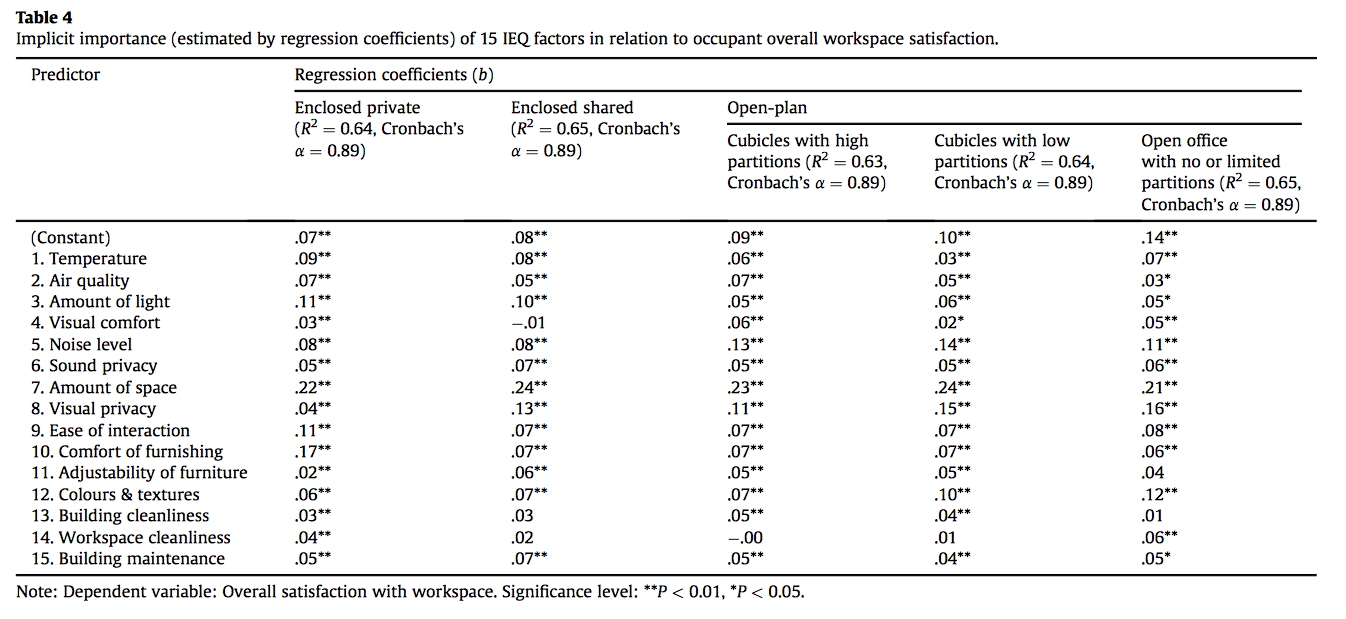 partitions) produced two regression coefficients (b1 and b2) for each IEQ factor; b1 increasing overall workspace satisfaction when the IEQ factor was perceived to be satisfactory, and b2 decreasing overall satisfaction when the IEQ factor was perceived to be unsatisfactory (Table 5). For example, when occupants are satisfied with the amount of space in their individual workspace, the multiple regression model predicts a 0.41 (b1) unit increase in the overall workspace satisfaction score. When occupants are dissatisfied with the amount of space, their overall workspace rating decreases by 0.79 (b2).
partitions) produced two regression coefficients (b1 and b2) for each IEQ factor; b1 increasing overall workspace satisfaction when the IEQ factor was perceived to be satisfactory, and b2 decreasing overall satisfaction when the IEQ factor was perceived to be unsatisfactory (Table 5). For example, when occupants are satisfied with the amount of space in their individual workspace, the multiple regression model predicts a 0.41 (b1) unit increase in the overall workspace satisfaction score. When occupants are dissatisfied with the amount of space, their overall workspace rating decreases by 0.79 (b2).
One of the research aims raised in the introduction of this paper was to quantitatively evaluate the trade-off in open plan office layouts between the positive impact of ease of interaction  between colleagues on the one hand, and the negative impact of noise and loss of privacy on the other. According to Table 5, the positive impact (b1) of ease of interaction on overall workspace satisfaction was 0.21, whereas the negative impacts (b2) of noise, poor sound and visual privacy was 0.41, 0.20 and 0.46 respectively (predictors in bold in Table 5). For example, when occupants in an open-plan office perceive that their office layout improves their interaction with co-workers, but degrades acoustical quality, sound and visual privacy, the cons outweigh the pros, and their overall workspace satisfaction score shows a net decrease of 0.86 units (i.e. 0.21 – 0.41 – 0.20 – 0.46 = –0.86).
between colleagues on the one hand, and the negative impact of noise and loss of privacy on the other. According to Table 5, the positive impact (b1) of ease of interaction on overall workspace satisfaction was 0.21, whereas the negative impacts (b2) of noise, poor sound and visual privacy was 0.41, 0.20 and 0.46 respectively (predictors in bold in Table 5). For example, when occupants in an open-plan office perceive that their office layout improves their interaction with co-workers, but degrades acoustical quality, sound and visual privacy, the cons outweigh the pros, and their overall workspace satisfaction score shows a net decrease of 0.86 units (i.e. 0.21 – 0.41 – 0.20 – 0.46 = –0.86).
4. Discussion
According to mean satisfaction ratings (Fig. 1) and dissatisfaction rates (Fig. 2) for the 15 IEQ factors, enclosed private offices were rated most positively of all five office layouts. This finding 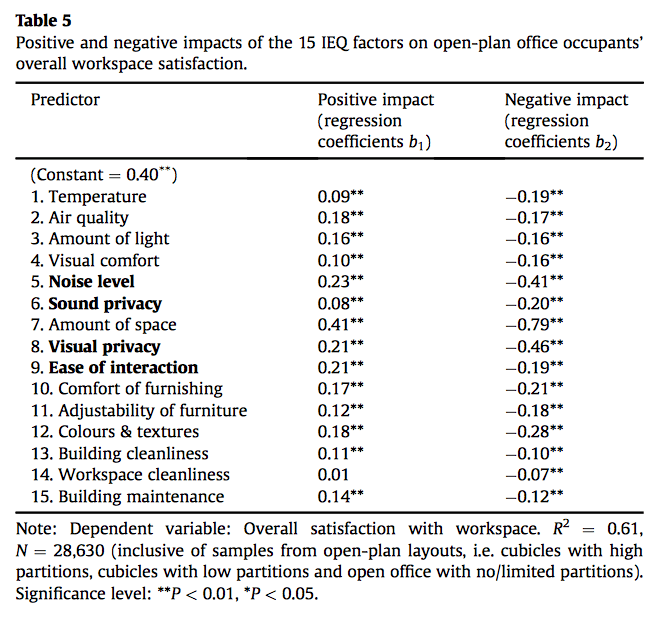 corroborates generalisations from earlier research literature on this subject (e.g. Danielsson & Bodin, 2009; Marans & Spreckelmeyer, 1982). Compared to the high level of occupant satisfaction of enclosed private office on visual privacy (mean satisfaction score =+2.0, APD = 3%), acoustical privacy achieved relatively poorer assessments in the same cellular offices (mean satisfaction score =+0.6, APD = 18%), suggesting that many private offices provide acoustical isolation below occupants’ expectations. This probably reflects the light-weight materials and expedient construction approaches commonly used in large commercial tenancy fit-outs. Nevertheless, private office users were generally satisfied with most of the IEQ factors, with the possible exception of thermal environment. Achieving high levels of thermal comfort is rare, even in private cellular offices, as indicated by relatively low satisfaction scores and significant numbers of potential complainants (mean satisfaction score =+0.2, APD = 22%).
corroborates generalisations from earlier research literature on this subject (e.g. Danielsson & Bodin, 2009; Marans & Spreckelmeyer, 1982). Compared to the high level of occupant satisfaction of enclosed private office on visual privacy (mean satisfaction score =+2.0, APD = 3%), acoustical privacy achieved relatively poorer assessments in the same cellular offices (mean satisfaction score =+0.6, APD = 18%), suggesting that many private offices provide acoustical isolation below occupants’ expectations. This probably reflects the light-weight materials and expedient construction approaches commonly used in large commercial tenancy fit-outs. Nevertheless, private office users were generally satisfied with most of the IEQ factors, with the possible exception of thermal environment. Achieving high levels of thermal comfort is rare, even in private cellular offices, as indicated by relatively low satisfaction scores and significant numbers of potential complainants (mean satisfaction score =+0.2, APD = 22%).
Even though ‘sound privacy’ were rated lower than the other IEQ factors in cellular offices, mean scores were still slightly above the line on the satisfaction scale. In contrast, open-plan office occupants expressed significant levels of dissatisfaction with ‘sound privacy’ (i.e. strongly negative mean scores on the satisfaction scale). In all three formats of open plan office the mean satisfaction scores on ‘temperature’, ‘noise level’, ‘sound privacy’, and ‘visual privacy’ were mostly negative but ‘sound privacy’ was over-whelmingly the most unsatisfactory IEQ factor in these offices. Also, the mean satisfaction scores for ‘amount of space’ in all three formats of open plan office was still on the positive side, but considerably lower compared to private office layouts. These results confirm the typically negative evaluations of open-plan layout reported by earlier researchers, i.e. lack of privacy, distraction by noise, feeling of crowding, uncontrolled social interactions and interruptions (e.g. de Croon et al., 2005; Ferguson, 1983; Kaarlela-Tuomaala et al., 2009; Yildirim, Akalin-Baskaya, & Celebi, 2007).
Among various sources of disturbance in open-plan offices, previous researches consistently highlight irrelevant but intelligible speech as the main cause of deteriorating cognitive processing (Haka et al., 2009; Smith-Jackson & Klein, 2009; Virjonen et al., 2007). Our analysis also has shown that sound privacy, defined in the CBE questionnaire as the ability to have conversations without neighbours overhearing and vice-versa, was the most problematic IEQ issue in open-plan office configurations. Sound privacy elicited the highest levels of IEQ dissatisfaction in open plan offices, and partitions were largely ineffectual at ameliorating this problem. A field study by O’Neill and Carayon (1993) demonstrated a positive relationship between the physical degree of enclosure (number and height of partitions) and perceived privacy. Our results on visual privacy support this finding. There was a significant decrease in dissatisfaction with the visual privacy of open plan offices as the degree of enclosure increased from no partition, to low partition, to high partition. However, in terms of sound privacy, the number of partitions and partition height had no impact on occupant dissatisfaction in our analysis; partitions improve visual privacy but don’t effectively block sound transmission between adjacent workstations. In fact, workspaces with no or limited partitions registered higher satisfaction and lower APD for ‘sound privacy’ and ‘noise level’ than did cubicles with high or low partitions. This counter-intuitive finding could be explained by the enhanced visual connectivity of workstations without any enclosing partitions. Empirical studies suggest that uncontrollability or unpredictability rather than the intensity exerts the stronger influence on occupants’ perception of their acoustical environment (Evans & Johnson, 2000; Haapakangas et al., 2008). That is, occupants of enclosed cubicles are partially disconnected visually from their surroundings and hence, unable to determine the source of sounds. This visual isolation may cause ambient noise to be more disturbing than when the sound source can be readily identified (Maher & von Hippel, 2005).
The implicit importance of individual IEQ factors derived by multiple regression models revealed subtle nuances in the POE database overlooked in the descriptive analyses presented above. It seems that occupant satisfaction levels on a particular IEQ factor don’t necessarily translate directly to the implicit importance of that IEQ factor on overall workspace satisfaction. For example, ‘amount of space’ didn’t stand out on either mean satisfaction ratings or the APD index, and yet it exerted the strongest influence on occupants’ overall assessment of their workspace (Fig. 3). This result is consistent with the findings of previous field studies on overall workspace satisfaction and work performance (Kupritz, 2003; Marans & Spreckelmeyer, 1982). Furthermore the magnitude of impact of ‘amount of space’ on overall workspace satisfaction significantly outweighed that of all the other IEQ factors in this analysis, regardless of office layout or configuration. Another example is ‘sound privacy’; although a large number of occupants expressed dissatisfaction with the sound privacy of their work-space, its impact on overall workspace satisfaction was relatively small. Perhaps the ability to hold confidential conversations (i.e. sound privacy) is not a basic expectation of office workers, whereas the amount of space available for individual work is apparently an essential requirement or baseline expectation (Kim & de Dear, 2012).
Some IEQ factors such as ‘visual privacy’, ‘noise level’, ‘ease of interaction’, and ‘amount of light’ demonstrated differential impact on overall workspace satisfaction, depending on the office layout configurations (Fig. 3). And this finding led to speculation that IEQ attributes that are widely perceived to be poor or inferior by certain occupant groups tend to assume greater significance for that particular group than another group of occupants for whom the IEQ attribute in question is generally performing well. Examples from the current analysis of CBE’s POE database include higher implicit importance of ‘visual privacy’ and ‘noise level’ for occupants of open-plan offices, and ‘ease of interaction’ for private cellular office occupants. In other words, acoustical issues become more important to those who are likely to experience more frequent noise disruptions and lack of sound privacy in open-plan offices, whereas interaction between co-workers is perceived to be more important to those who are located in private office. Applying the same logic to other IEQ attributes, the higher importance of ‘amount of light’ for occupants in enclosed offices can be accounted for, because one of the architectural features of open-plan is to introduce more daylight throughout the workspace. Consequently open-plan office occupants are more likely to be provided with sufficient light than those in enclosed offices.
In introduction section of this paper we posed the primary research question as a trade-off between interaction and privacy/noise in open-plan offices. The common assumption within the commercial office building sector is that occupants in open-plan office are more satisfied with accessibility of their colleagues and team members than their counterparts in private office, but this hypothesis was rejected in earlier field research (Haapakangas et al., 2008; Kaarlela-Tuomaala et al., 2009; Sundstrom et al., 1982). Some researchers speculate that open-plan actually discourages communication between colleagues and team members due to the lack of confidentiality in that office configuration (Kupritz, 2003; Sundstrom et al., 1982). Also, a field study by Duffy (1992) reported no relationship between the employee interaction (as by measured frequency of face-to-face transactions) and the level of subdivision of office layout (i.e. open-plan = low subdivision vs. cell-office = high subdivision). Results from our analyses of the CBE POE database are consistent with these earlier observations. In our analysis, the open-plan office occupants’ satisfaction level with ‘ease of interaction’ was no higher than that of private office occupants (Fig. 1). Besides, the dissatisfaction rate with ‘ease of interaction’ was very low (APD = 5–8%) across all office configurations, suggesting that interaction is not a major issue in any type of office configuration. For these reasons, simply linking open-plan layout to facilitation of communication between co-workers, by extension, organisational efficiency and productivity has scant empirical evidence supporting it. The dummy variable regression model clearly demonstrated that positive impact of ease of interaction didn’t offset the negative impacts of noise and privacy issues in relation to open-plan occupants’ workspace satisfaction (Table 5). The regression model’s predicted decrements in overall workspace satisfaction due to unsatisfactory privacy and acoustic issues were bigger than the predicted increment due to ease of communication. Examining the association between environmental satisfaction and productivity is beyond the scope of this paper. But considering the previous researchers’ finding that satisfaction with workspace environment is closely related to perceived productivity (Leaman & Bordass, 2007), job satisfaction (de Croon et al., 2005; Sundstrom et al., 1994) and organisational outcomes (Veitch et al., 2007; Wineman, 1986), the open-plan proponents’ argument that open-plan improves morale and productivity appears to have no basis in the research literature.
There are some limitations of this study that suggest useful avenues for future research in the area of POE. The classification of office layouts used in our analysis is based on the self-report by occupants. Survey respondents were asked to select one option that best describes their workspace. Hence it didn’t capture some additional features that might have had an effect on occupants’ spatial perception, such as spatial density, number of people sharing, and proximity to window.
5. Conclusion
By analysing a large POE database from CBE, this study identified that survey responses on various IEQ issues differ between different office layouts (classified as enclosed private, enclosed shared, cubicles with high partitions, cubicles with low partitions, and open office with no/limited partitions). In general, satisfaction level with workspace environment was the highest for those in enclosed private offices. Significant discrepancy existed between occupant groups in private office and open-plan office on their perception of privacy, acoustics and proxemics. Distraction by noise and loss of privacy were identified as the major causes of workspace dissatisfaction in open-plan office layouts. Multiple regression analysis indicated that relative importance of different IEQ factors affecting occupants’ overall assessment of their work environment was different for occupants of different office layouts. While the amount of individual space available was identified as the most important predictor of overall workspace satisfaction across all five office layouts, some other IEQ factors also showed noticeable differences in their implicit importance. ‘Visual privacy’ and ‘noise level’ received higher priorities by open-plan office occupants, whereas ‘amount of light’, ‘ease of interaction’ and ‘comfort of furnishing’ were more important to private office occupants. Finally, our results categorically contradict the industry-accepted wisdom that open-plan layout enhances communication between colleagues and improves occupants’ overall work environmental satisfaction. This study showed that occupants’ satisfaction on the interaction issue was actually higher for occupants of private offices with very low dissatisfaction rate (APD < 5%). Moreover, the increment of overall workspace satisfaction due to the positive impact of ease of interaction in open-plan office layouts failed to offset the decrements by negative impacts of noise and privacy. This implies that even though occupants are satisfied with interactions in open-plan layout, their overall workspace satisfaction will eventually decreased unless a certain level of privacy and acoustical quality are provided.
Acknowledgement
The authors thank Center for the Built Environment at the University of California, Berkeley, for generously permitting our access to CBE’s occupant IEQ survey database for this analysis. We also would like to acknowledge Monika Frontczak from International Centre for Indoor Environment and Energy at Technical University of Denmark, for her valuable work in organizing and formatting the database.
